Climate-tough thorny hedges offer natural security without compromising aesthetics. For drought resistance, try Pyracantha, native roses, or prickly pear cacti. In wet, cold areas, consider Blackthorn or Hawthorn varieties. Holly and diverse hedgerows adapt to changing conditions, while Barberry withstands extreme temperatures. For coastal properties, Sea Buckthorn thrives in salty conditions. You’ll find the perfect protective barrier that stands strong against both intruders and challenging weather conditions below.
Drought-Resistant Pyracantha: The Fiery Barrier
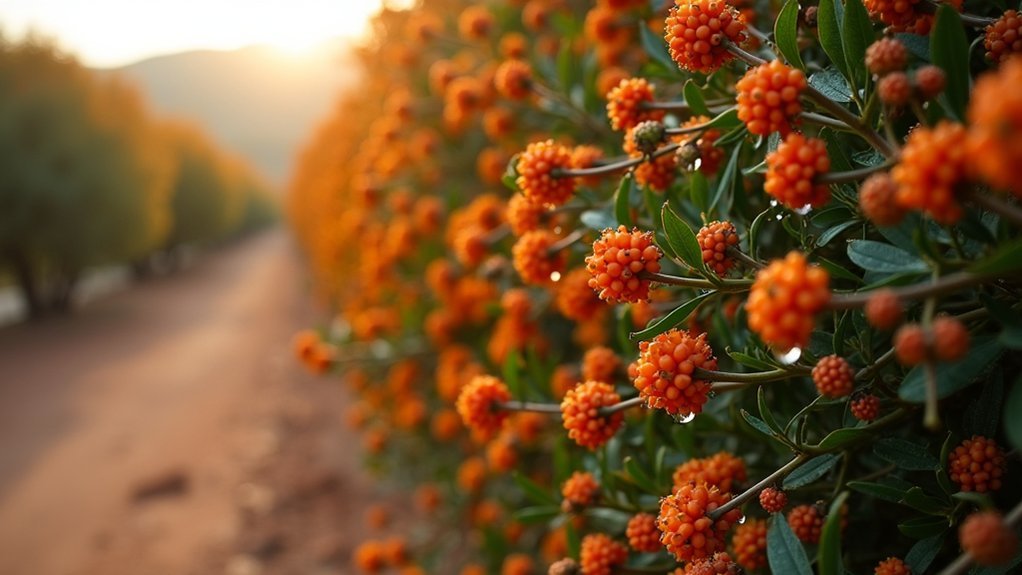
While many homeowners focus solely on traditional security solutions, Pyracantha offers a natural alternative that combines protection with beauty. This thorny evergreen shrub creates an effective barrier against intruders while adding vibrant seasonal interest to your landscape.
Thriving in USDA Zones 6-9, Pyracantha adapts to various soil types and requires minimal water once established—perfect for arid regions. You’ll enjoy its stunning orange and red berries in fall, which attract birds while enhancing your garden’s appeal.
Train your Pyracantha against walls or fences to maximize its security function and aesthetic value. Regular pruning encourages denser growth, creating an even more impenetrable barrier.
With proper maintenance, you’ll have a formidable deterrent that’s both beautiful and functional—all while conserving water in your landscape.
Barberry Varieties for Extreme Temperature Zones
When other security plants surrender to harsh weather conditions, barberry varieties stand resilient as the ultimate extreme climate defenders. If you’re seeking a thorny hedging solution that won’t wilt under pressure, barberry delivers exceptional performance across USDA zones 3-8.
- Japanese Barberry (Berberis thunbergii) creates an impenetrable barrier while tolerating temperatures down to -30°F.
- Crimson Pygmy Barberry grows to 3 feet tall, perfect for compact security applications.
- Common Barberry (Berberis vulgaris) adapts to poor soil conditions while maintaining its defensive qualities.
- Dense, thorny branches deter intruders while adding seasonal color to your landscape.
- Once established, these plants require minimal maintenance while providing year-round security.
You’ll appreciate barberry’s combination of security functionality and aesthetic appeal—a thorny barrier that’s as beautiful as it’s protective.
Holly Species That Thrive in Changing Climates

Among adaptable Ilex varieties, English holly stands out for its ability to thrive in diverse soil types while maintaining year-round security with its prickly foliage.
You’ll find drought-resistant holly options increasingly valuable as climate patterns shift, with certain varieties showing remarkable tolerance to both heat stress and water scarcity.
When establishing your security hedge, consider these climate-resilient holly species that can grow up to 15 feet tall while requiring only minimal maintenance to remain dense and effective barriers.
Adaptable Ilex Varieties
As climate patterns shift across regions, Ilex varieties stand out as remarkably adaptable thorny hedge options for security-conscious property owners.
You’ll find these versatile plants serve as an effective deterrent while thriving in diverse environments from USDA zones 5-9.
- Common Holly (Ilex aquifolium) features sharp, spiky leaves that discourage intruders year-round.
- American Holly (Ilex opaca) tolerates poor soil and urban pollution, perfect for challenging landscapes.
- These adaptable Ilex varieties can be shaped into dense hedges that block sightlines for enhanced privacy.
- Their resilient nature guarantees your security barrier remains intact through seasonal changes.
- Attractive berries draw birds and wildlife, adding biodiversity while maintaining your protective boundary.
These adaptable evergreens offer the perfect combination of security and aesthetic appeal, regardless of your climate challenges.
Drought-Resistant Holly Options
Climate resilience has become a top priority for security-minded gardeners, and drought-resistant holly options offer exceptional protection even during water-scarce periods.
Japanese holly (Ilex crenata) thrives in USDA zones 5-9 with minimal watering once established, making it an ideal drought tolerant barrier.
Common holly (Ilex aquifolium) maintains its dense, prickly foliage year-round despite dry conditions, creating an effective deterrent against intruders.
You’ll appreciate how these adaptable plants flourish in various soil types—from sandy to clay—increasing their resilience during unpredictable weather patterns.
The thorny stems and sharp leaves serve dual purposes: creating an attractive aesthetic barrier while actively discouraging wildlife and trespassers.
Even better, many holly varieties perform well in partial shade, giving you flexible placement options while maintaining their security benefits.
Sea Buckthorn: The Salt-Tolerant Defensive Hedge
Sea buckthorn creates an exceptional defensive barrier for your coastal property with its dense growth habit and sharp thorns that deter unwanted visitors.
You’ll appreciate its remarkable salt tolerance and ability to thrive in poor soils where other hedging plants struggle to survive.
Beyond security, your sea buckthorn hedge will attract diverse wildlife with its vibrant orange berries while simultaneously stabilizing soil and preventing erosion in challenging environments.
Coastal Defense Champion
The ultimate defender of coastal property lines, sea buckthorn (Hippophae rhamnoides) stands as a thorny sentinel against both human intruders and harsh maritime conditions.
You’ll find this shrub creates effective natural barriers while thriving where other plants surrender to salt spray and poor soils.
- Grows up to 10 feet tall with dense, thorny branches that form an impenetrable security hedge
- Produces vibrant orange berries rich in nutrients that attract wildlife
- Requires minimal maintenance once established due to exceptional drought tolerance
- Develops an extensive root system that prevents coastal erosion
- Adapts to challenging environments, making it perfect for properties with difficult growing conditions
This maritime warrior’s combination of defensive thorns and environmental resilience makes it an unmatched solution for coastal property security that works with, not against, your challenging seaside landscape.
Vibrant Wildlife Magnet
Beyond its formidable defensive capabilities, your sea buckthorn hedge transforms into a bustling wildlife sanctuary throughout the seasons. The vibrant berries provide essential nutrients for local and migratory birds, creating a living barrier around your property that’s as ecologically valuable as it’s secure.
These orange-gold fruits, packed with vitamins C and E, attract pollinators when flowering and hungry birds during fruiting season.
As you establish this thorny 10-foot barrier, you’re simultaneously creating critical habitat for small animals that nest within its protective branches.
You’ll appreciate how this wildlife-friendly security solution requires minimal maintenance once established.
The drought-resistant nature of sea buckthorn means you won’t sacrifice sustainability for security—instead, you’ll create a thriving ecosystem that actively strengthens your property’s defensive perimeter.
Blackthorn Hedges for Wet and Cold Environments
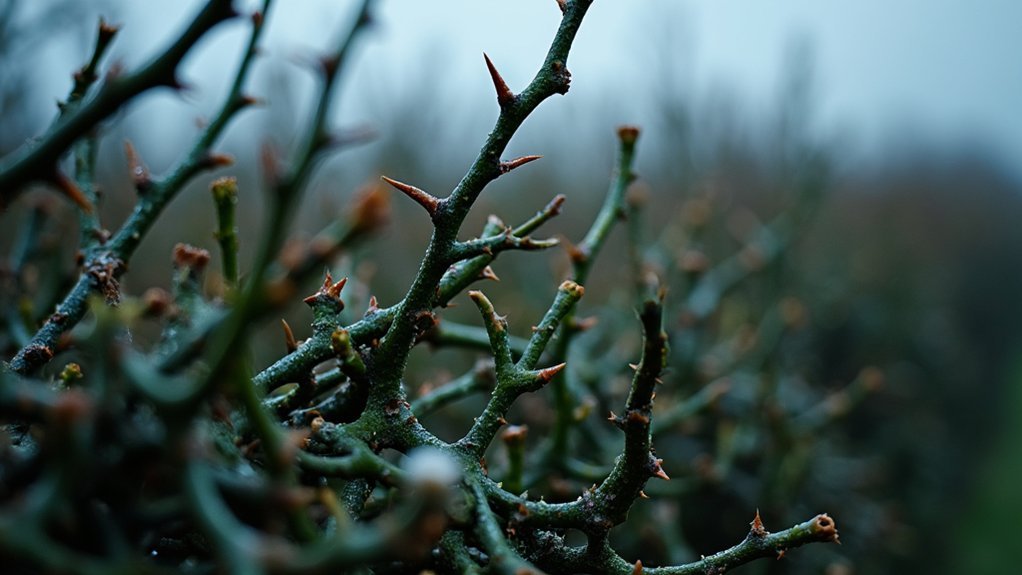
While many security hedges struggle in challenging climates, Blackthorn (Prunus spinosa) stands out as an exceptional choice for wet and cold environments. This deciduous shrub thrives in USDA Hardiness Zones 4-8, where temperatures drop considerably.
- Reaches impressive heights of up to 13 feet with dense, thorny growth that deters intruders
- Produces delicate white flowers in early spring, attracting beneficial pollinators
- Develops dark sloe berries in fall, adding seasonal interest to your property
- Requires minimal maintenance once established, saving you time and resources
- Withstands poor soil conditions and harsh weather, making it perfect for difficult sites
You’ll appreciate blackthorn’s dual benefits of security and aesthetics while enjoying its remarkable resilience in damp, cold conditions where other hedging options might fail.
Resilient Hawthorn Varieties for Urban Security
Urban environments present unique security challenges that require tough, adaptable plant solutions. You’ll find resilient hawthorn varieties perfectly suited for these demands, reaching heights of 15 feet while thriving in hardiness zones 4-8.
These hardy shrubs adapt well to poor soils and pollution, making them ideal for city settings. Their dense, thorny branches form an impenetrable barrier that serves as an effective deterrent against intruders while creating privacy for your property.
You’ll enjoy hawthorn’s aesthetic benefits too—delicate white or pink spring flowers followed by vibrant red or orange fall berries that attract beneficial wildlife.
Regular trimming enhances the hedge’s density, strengthening its security function. By incorporating hawthorn into your urban landscape, you’re investing in a natural security system that contributes to local biodiversity.
Desert-Adapted Cacti Barriers for Arid Regions
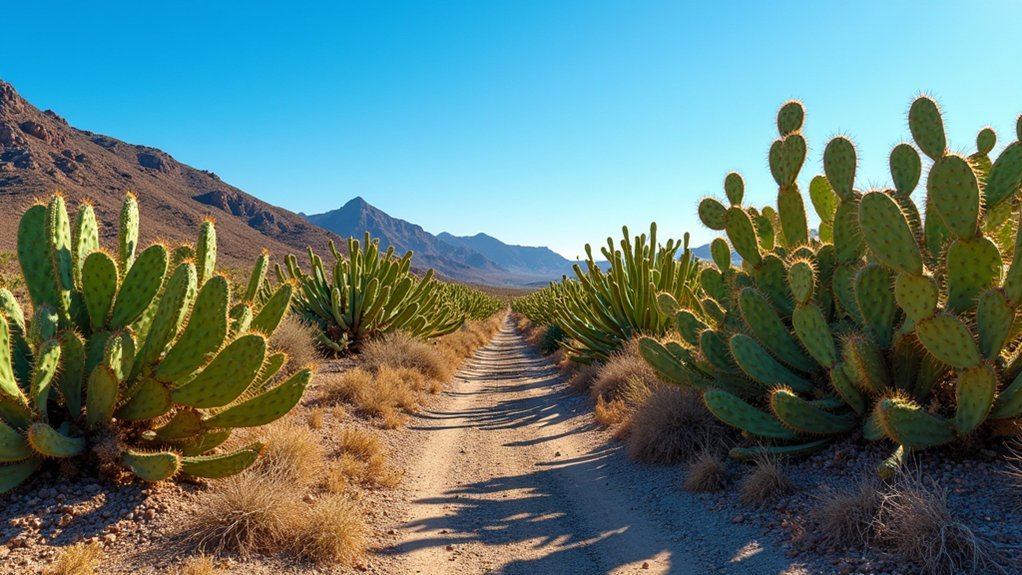
If you’re living in arid regions where water conservation is essential, desert-adapted cacti offer impressive security solutions that thrive in harsh conditions.
These natural deterrents create formidable barriers while adding striking visual elements to your landscape.
- Prickly pear (Opuntia) varieties require minimal water yet form dense barriers that effectively deter intruders.
- Some cacti species grow up to 10 feet tall, creating imposing perimeter protection.
- Their sharp spines provide a natural security system without electricity or maintenance costs.
- You’ll attract beneficial wildlife while enhancing your property’s protection.
- Once established, these desert-adapted cacti need almost no maintenance, saving you time and resources.
For homeowners in desert climates, cacti hedges combine practical security with sustainable landscaping—a perfect solution when you need dependable protection that won’t strain your water bill.
Native Roses With Thorny Defenses for Regional Climates
Native roses offer powerful security through their thorny stems while adapting to your specific regional conditions, as shown in our Wild Roses Regional Map that highlights ideal varieties from coastal zones to inland areas.
You’ll find drought-resistant options like Rosa rugosa and Rosa carolina that require minimal watering while providing dense, impenetrable barriers up to 5 feet tall.
These resilient plants deliver multi-season defense features with thorny protection year-round, plus the added benefits of spring blooms and winter rose hips that attract beneficial wildlife to your security perimeter.
Wild Roses Regional Map
The exceptional adaptability of wild roses across diverse climate zones makes them valuable security assets for virtually any property in North America.
You’ll find suitable wild roses for security hedges regardless of your location within USDA Hardiness Zones 2-9.
- In northern regions (Zones 2-6), consider Rosa acicularis with its sharp thorns and cold-hardiness for impenetrable barriers.
- Coastal properties benefit from Rosa rugosa, which thrives in sandy soils and withstands salt spray while providing robust protection.
- For Midwest landscapes (Zones 4-8), Rosa multiflora creates dense thickets that deter intruders effectively.
- Southern gardens (Zones 5-9) flourish with Rosa gallica, combining security with beautiful, fragrant blooms.
Once established, these wild roses require minimal maintenance while offering year-round protection across drought-prone or variable climate regions.
Drought-Resistant Varieties
Beyond regional adaptability, property owners in arid climates need thorny hedges that can thrive with minimal water. Native roses like Rosa californica offer exceptional drought-resistant qualities while providing robust security barriers.
These indigenous varieties establish thorny defenses that discourage intruders without sacrificing beauty. You’ll enjoy vibrant blooms that attract pollinators, enhancing your property’s biodiversity while maintaining effective protection.
For ideal hedging options, plant these roses in well-draining soil under full sun. Once established, they’ll require minimal irrigation, substantially reducing your maintenance costs and environmental footprint.
The dual benefit of these drought-resistant roses lies in their practicality: they create visually appealing boundaries that harmonize with local climate conditions while forming formidable physical barriers that enhance your property’s security naturally and sustainably.
Multi-Season Defense Features
Effective year-round protection comes from native roses that maintain their defensive characteristics regardless of season, unlike deciduous plants that lose their deterrent capabilities in winter.
You’ll find Rosa rugosa and similar species create formidable security hedges while adapting to your regional climate conditions.
- Dense growth patterns create impenetrable barriers that intruders can’t easily breach
- Prickly stems provide natural deterrence even when plants aren’t actively flowering
- Species native to South America offer particularly robust thorny defenses in warmer regions
- Year-round foliage guarantees privacy and security without seasonal compromises
- Strategic planting maximizes defensive coverage while supporting local biodiversity
These thorny defenders require minimal maintenance while offering maximum protection, making them ideal for property boundaries where security concerns exist alongside aesthetic considerations.
Their ability to attract beneficial wildlife further enhances their value beyond mere defensive applications.
Bougainvillea: Thorny Protection for Warm Climates
For residents in sun-drenched regions seeking both beauty and security, Bougainvillea stands out as a spectacular thorny barrier option.
Native to South America, this resilient plant thrives in USDA Hardiness Zones 9-11, demanding full sun to produce its signature colorful bracts.
You’ll appreciate Bougainvillea’s dual nature as a security solution. Its sharp thorns create effective thorny protection against intruders while its vibrant blooms enhance your landscape from spring through fall.
Once established, you won’t need to fuss with excessive watering or maintenance, making it perfect for xeriscaping projects.
Train your Bougainvillea along fences, walls, or trellises to create an impenetrable yet beautiful privacy screen. Its climbing habit allows you to direct growth precisely where you need enhanced security while adding tropical elegance to your property.
Creating Multi-Species Thorny Hedgerows for Climate Resilience
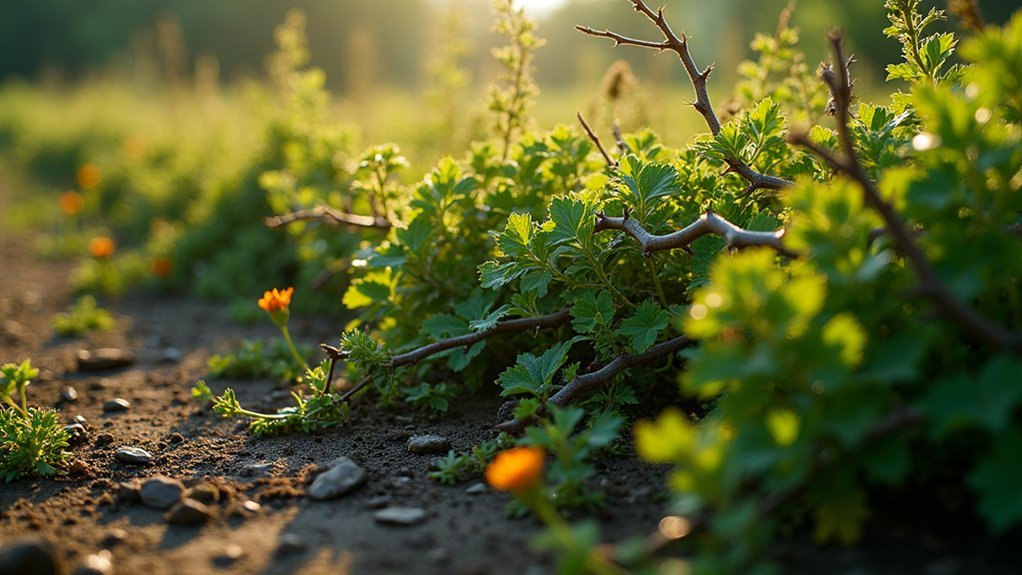
While single-species barriers offer simplicity, cultivating diverse thorny hedgerows provides superior climate resilience and long-term security benefits.
By combining different species like blackthorn, holly, and pyracantha, you’ll create a defensive barrier that adapts to changing environmental conditions.
Multi-species hedgerows offer:
- Natural insurance against pest outbreaks that might devastate a single-species planting
- Enhanced microclimates that protect vulnerable plants during extreme weather
- Support for a wide range of beneficial wildlife that strengthen your garden’s ecosystem
- Better adaptation to varying soil conditions across your property
- Reduced maintenance needs as native thorny species typically require less intervention
This strategic approach guarantees your security barrier remains effective regardless of climate challenges, creating a sustainable, low-maintenance solution that improves with age while supporting local biodiversity.
Frequently Asked Questions
What Is the Best Thorn Bush for Security?
For security, you’ll find Firethorn (Pyracantha) is your best choice. It’s dense, has sharp thorns, grows vibrantly, and attracts wildlife. Blackthorn also works well with its quick growth and formidable thorny branches.
What Is the Best Impenetrable Hedge Plant?
For impenetrable hedges, you’ll find Firethorn (Pyracantha) is your best option. It combines sharp thorns with dense growth, creating a barrier intruders can’t penetrate while offering attractive berries that wildlife love.
What Is the Best Hedge for Security?
For security, you’ll find Blackthorn most effective with its impenetrable 13-foot height and vicious thorns. Firethorn offers dense growth with sharp thorns, while Holly provides year-round protection with its prickly leaves and thick foliage.
What Is the Best Barrier Hedge?
The best barrier hedge for your property is Pyracantha or Barberry. They’ll give you dense growth with thorny protection that deters intruders while maintaining privacy. Don’t forget to prune regularly for ideal effectiveness.
In Summary
You’ll find that thorny hedges offer dual benefits of security and climate resilience. By selecting species suited to your region’s specific challenges, you’re creating living barriers that withstand drought, flooding, or temperature extremes. Whether you’re facing salt spray, desert conditions, or unpredictable rainfall, there’s a thorny solution that’ll thrive while protecting your property. Embrace these natural defenses as sustainable alternatives to conventional fencing.

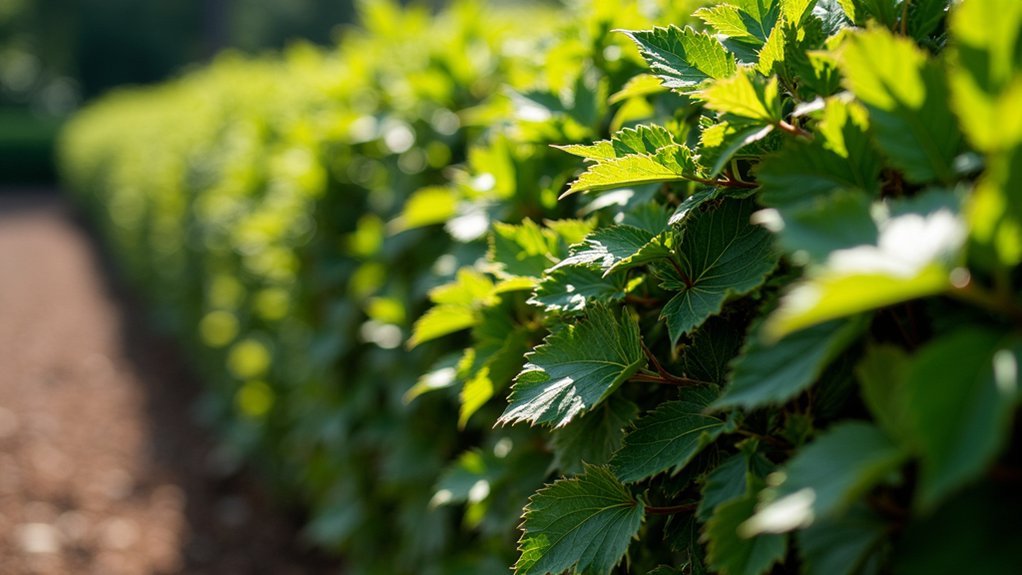



Leave a Reply